The use and prevalence of lead has impacted societies for millennia. While we are well aware of the impacts of lead on modern public health, recent developments in archaeological science has painted a clearer picture of its impact in the past.
In this webinar WSLH Isotope Geochemist Sean Scott explains new research detailing the environmental and public health effects of lead in antiquity, specifically associated with its uses in the Roman Empire. Sean also discusses how environmental implications of past societies compare to similar challenges we face today in Wisconsin.
Webinar link – https://slhstream2.ad.slh.wisc.edu/Mediasite/Play/521689718baa46299303aa0c613fabb51d
Resources to learn more
Archaeometry – Elevated lead exposure in Roman occupants of Londinium: New evidence from the archaeological record
Online References
https://www.chemistryworld.com/news/londinium-romans-blood-lead-levels-so-high-they-may-have-lowered-birth-rates/4010808.article
https://www.bbc.com/news/uk-england-39366713
https://commons.wikimedia.org/wiki/File:Roman_lead_pipe_ostia_antica_04.jpg
Agency for Toxic Substances and Disease Registry, Centers for Disease Control and Prevention (CDC) (https://www.atsdr.cdc.gov/csem/csem.asp?csem=34&po=10)
https://www.wisconsinhistory.org/
Scientific Papers
Bollhofer A, Rosman KJR (2001) Lead isotopic ratios in European atmospheric aerosols. Phys Chem Earth Pt B 26:835-838 doi:Doi 10.1016/S1464-1909(01)00094-6
Alvarez-Fernandez, N., Cortizas, A.M., Lopez-Costas, O., 2020, Atmospheric mercury pollution deciphered through archaeological bones. Journal of Archaeological Science, 119, 105159
Delile, H., Blichert-Toft, J., Goiran, J. P., Keay, S., and Albarède, F., 2014, Lead in ancient Rome’s city waters, Proceedings of the National Academy of Science, 111(18), 6594–9.
Diaz-Somoano M et al. (2009) Stable Lead Isotope Compositions In Selected Coals From Around The World And Implications For Present Day Aerosol Source Tracing. Environ Sci Technol 43:1078-1085 doi:10.1021/es801818r
Durali-Mueller, S., Brey, G. P., Wigg-Wolf, D., and Lahaye, Y., 2007, Roman lead mining in Germany: its origin and development through time deduced from lead isotope provenance studies. Journal of Archaeological Science, 34, 1555–67.
Flemming, D. E. B., Boulay, D., Richard, N. S., Robin, J.-P., Gordon, C. L., Webber, C. E., and Chettle, D. R., 1997, Accumulated body burden and endogenous release of lead in employees of a lead smelter, Environmental Health Perspectives, 105, 224–33.
Gilfillan, S. C., 1965, Lead poisoning and the fall of Rome, Journal of Occupational Medicine, 7, 53–60.
Hodge, A. T., 1981, Vitruvius, Lead Pipes and Lead Poisoning. American Journal of Archaeology, 85, 486–91.
Lopez-Costas, O., Kylander, M., Mattielli, N., Alvarez-Fernandez, N., Perez-Rodriguez, M., Mighall, T., Bindler, R., Cortizas, A.M. 2020. Human bones tell the story of atmospheric mercury and lead exposure at the edge of Roman World. Science of the Total Environment, 710:136319.
McConnell, J.R., Edwards, R., 2008, Coal burning leaves toxic heavy metal legacy in the Arctic. Proceedings of the National Academy of Sciences, 105, 12140-12144.
Montgomery, J., Evans, J. A., Powlesland, D., and Roberts, C. A., 2005, Continuity or colonization in Anglo-Saxon England? Isotope evidence for mobility, subsistence practice, and status at west Heslerton, American Journal of PhysicalAnthropology, 126, 123–38.
Montgomery, J., Evans, J. A., Chenery, S. R., Pashley, V., and Killgrove, K., 2010, ‘Gleaming, white, and deadly’: Usinglead to track human exposure and geographic origins in the Roman period in Britain, Journal of Roman Archaeology;Supplementary Series, 78, 199–226.
Nriagu, J. O., 1983, Lead and Lead poisoning in antiquity, Wiley, New York.
Patterson, C. C., Shirahata, H., and Ericson, J. E., 1987, Lead in ancient human bones and its relevance to historical developments of social problems with lead, The Science of the Total Environment, 61, 167–200.
Penney, S., and Shotter, D. C. A., 1996, An inscribed Roman salt-pan from Shavington, Cheshire, Britannia, 27,360–5.
Retief, F. P., and Cilliers, L., 2005, Lead poisoning in ancient Rome, Acta Theologica, 26, 147–64.
Scarborough, J., 1984, The myth of lead poisoning among the romans: An essay re-view, Journal of the History of Medicine and Allied Sciences, 39(4), 469–75.
Schwikowski, M., Barbante, C., Doering, T., Gaeggeler, H.W., Boutron, C., Shotterer, U., Tobler, L., Van de Velde, K., Ferrari, C., Cozzi, G., Rosman, K., Cescon, P., 2004, Post-17th Century changes of European lead emissions, recorded in high-altitude alpine snow and ice. Environmental Science and Technology, 38, 957-964.
Shafer, M. M., Siker, M., Overdier, J. T., Ramsl, P. C., Teschler-Nicola, M., and Farrell, P. M., 2008, Enhanced methods for assessment of the trace element composition of Iron-age bone, Science of the Total Environment, 401,144–61.
Shaw, H., Montgomery, J., Redfern, R., Gowland, R., and Evans, J., 2016, Identifying migrants in Roman London usinglead and strontium stable isotopes, Journal of Archaeological Science, 66, 57–68.
Sherman LS, Blum JD, Dvonch JT, Gratz LE, Landis MS (2015) The use of Pb, Sr, and Hg isotopes in Great Lakes precipitation as a tool for pollution source attribution. Science of the Total Environment 502:362-374 doi:10.1016/j.scitotenv.2014.09.034
Shotyk, W., Weiss, D., Appleby, P. G., Cheburkin, A. K., Frei, R., Gloor, M., Kramers, J. D., Reese, S., and Van DerKnaap, W. O., 1998, History of atmospheric Lead deposition since 12,370 14C yr BP from a peat bog, Jura Mountains,Switzerland, Science, 281, 1635–40.
Smith KE, Shafer MM, Weiss D, Anderson HA, Gorski PR (2017) High-Precision (MC-ICPMS) Isotope Ratio Analysis Reveals Contrasting Sources of Elevated Blood Lead Levels of an Adult with Retained Bullet Fragments, and of His Child, in Milwaukee, Wisconsin. Biological trace element research 177:33-42 doi:10.1007/s12011-016-0872-3
Stacey, J.S., Kramers, J.D., 1974, Approximation of terrestrial lead isotope evolution by a two-stage model. Earth and Planetary Sciences Letters, 26, 207-221.
Tzaphlidou, M., and Zaichick, V., 2003, Calcium, phosphorous, calcium–phosphorous ratio in rib bone of healthyhumans, Biological Trace Element Research, 93, 63–74.
Waldron, H. A., Mackie, A., and Townshend, A., 1976, The lead content of some Romano-British bones, Archaeometry, 18, 221–7.
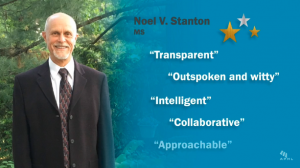
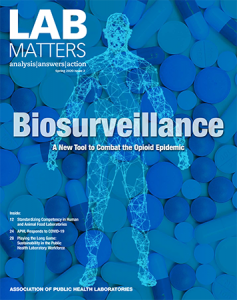
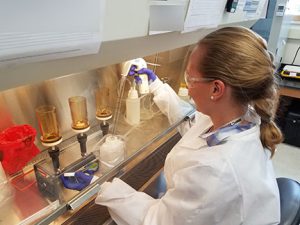
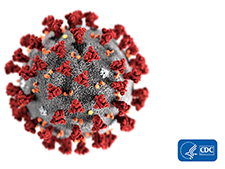 In addition to continued COVID-19 virus testing in the Communicable Disease Division, the WSLH response to the pandemic has expanded to include surveillance for the virus in wastewater as well as helping the state and local communities decontaminate PPE.
In addition to continued COVID-19 virus testing in the Communicable Disease Division, the WSLH response to the pandemic has expanded to include surveillance for the virus in wastewater as well as helping the state and local communities decontaminate PPE.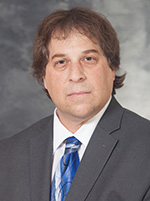 Wisconsin State Laboratory of Hygiene Director Jamie Schauer brings a unique vantage point to the COVID-19 response as both an internationally-recognized air pollution expert and as the leader of Wisconsin’s public health laboratory.
Wisconsin State Laboratory of Hygiene Director Jamie Schauer brings a unique vantage point to the COVID-19 response as both an internationally-recognized air pollution expert and as the leader of Wisconsin’s public health laboratory.